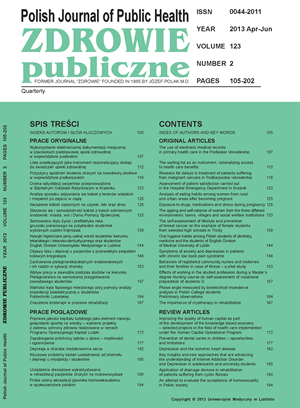Depression and the ischemic heart disease
DOI:
https://doi.org/10.12923/j.0044-2011/123-2/a.17Keywords:
depression, co-occurrenc, cardio-vascular diseaseAbstract
Depression and coronary heart disease are more and more frequently co-occurring illnesses. It is noticed that individuals falling to the severe episode of the ischemic heart disease are more often struck by depression. Individuals, at whom disorders appeared with the depressive background, present an increased risk of the ischemic heart disease development. An inherent prognostic element in the course of cardio-vascular illnesses is a mental state of the sick person. The key element of prevention and curing in cardio-vascular illnesses is an appropriate contact, full understanding of the problem of the ischemic heart disease, which in the course of depression are made difficult.
References
1. GUS. Rocznik statystyczny; 2009.
2. Gil K, Radziwiłłowicz P, Zdrojewski T, et al. Depresja jako czynnik ry¬zyka chorób układu sercowo-naczyniowego. Kardiol Pol. 2006;64:526-31.
3. Appels A. Depression and coronary heart disease: observations and questions. J Psychosom Res. 1997;5:443-52.
4. Rugulies R. Depression as a predictor for coronary heart disease: A re¬view and meta-analysis. Am J Prev Med. 2002;23:51-61.
5. Heymann-Szlachcińska A, Rybakowski J. Rola depresji w patogen¬ezie choroby niedokrwiennej serca. Psychiatr Prakt Ogólnolek. 2004;4 (3):95-101.
6. Kiejna A, Faluta T, Czech M, et al. Depresja – skutki ekonomiczne i społeczne. Dyskusje o depresji. 2002;18:2-5.
7. Pużyński S. Choroby afektywne. In: A. Bilikiewicz. Psychiatria. Podręcznik dla studentów. Warszawa: PZWL; 2004. p. 327-401.
8. Wciórka J. Kryteria diagnostyczne według DSM-IV-TR. Warszawa: Elsevier; 2008.
9. Moryś J, Frankiewicz A, Rynkiewicz A. Depresja jako czynnik ryzyka choroby wieńcowej. Terapia. 2009;9:230
10. Zellweger MJ, Osterwalder RH, Langewitz W, Pfisterer ME. Coronary artery disease and depression, Eur Heart J. 2004;1:3-9.
11. Wulsin LR, Vaillant GE, Wells VE. A systematic review of the mortality of depression. Psychosom Med. 1999;61:6-17.
12. Frasuse-Smith N, Lesperance F, Talajic M. Depression following myocardial infarction. Impact on 6-month survival. J Am Med Assoc. 1993;270:1819-25 .
13. Hippisley-Cox JK, Fielding K, Pringle M. Depression as a risk factor for ischaemic heart disease in men: Population based case-control study. Br Med J. 1998;316:1714-9.
14. Weber-Hamann B, Hentschel F, Kniest A, et al. Hypercortisolemic de¬pression is associated with increased intra-abdominal fat. Psychosom Med. 2002;64:274-7.
15. Serebruany VL, Gurbel PA, O’Connor CM. Platelet inhibition by certa¬line and N-desmethylimipramine: A possible missing link between de¬pression, coronary evens and mortality benefits of selective serotonine reuptake inhibitors. Pharmacol Res. 2001;43:453-62.


